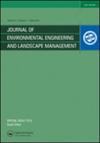EVALUATION OF THE DISPERSANTS EFFECTIVENESS USING THE BAFFLED FLASK TEST
IF 1.1
4区 环境科学与生态学
Q4 ENVIRONMENTAL SCIENCES
Journal of Environmental Engineering and Landscape Management
Pub Date : 2022-02-03
DOI:10.3846/jeelm.2022.16317
引用次数: 1
Abstract
The use of chemical dispersants is one of the most widely used methods for responding to oil spills. The most important characteristic of dispersants is their effectiveness. The dispersant effectiveness is a measure of how well the dispersant breaks up and stabilizes the oil into the water column. In this paper, we studied the dispersing ability of three proprietary dispersants with respect to light and heavy crude oils of Usinsk and Nagornoye fields with a density of 0.816 g/cm3 and 0.896 g/cm3, respectively. The dispersant effectiveness was determined using a Baffled Flask Test; dispersant was applied to the oil slick, mixed, and the concentration of oil in a sample taken from the water column was measured using UV-Visible spectrophotometry. A modification of the standard technique is proposed to minimize the error of the method for the heavy crude oil by eliminating the error associated with inaccuracy of dosing. For this purpose, oil of the Nagornoye field was added to the tested systems not “by volume”, but “by weight”. It was provided better convergence of the experimental results. The standard deviation in the case of dosing of oil “by volume” exceeded 10% and varied from 11.87% to 13.59%. The introduction of oil “by weight” was much lower and varied from 5.66% to 6.30%. Studied dispersants have a higher dispersing ability for the less dense oil of the Usinsk field.用折流板烧瓶试验评价分散剂的有效性
使用化学分散剂是应对石油泄漏最广泛使用的方法之一。分散剂最重要的特点是其有效性。分散剂的有效性是衡量分散剂分解和稳定油进入水柱的程度。本文研究了三种专用分散剂对Usinsk油田和Nagornoye油田轻质原油和重质原油的分散能力,密度分别为0.816g/cm3和0.896g/cm3。使用挡板烧瓶试验测定分散剂的有效性;将分散剂应用于浮油,混合,并使用紫外-可见分光光度法测量从水柱中提取的样品中的油浓度。建议对标准技术进行修改,通过消除与定量不准确相关的误差,将重质原油方法的误差降至最低。为此,纳戈尔诺耶油田的石油不是“按体积”而是“按重量”添加到测试系统中。实验结果具有较好的收敛性。在“按体积”投加油的情况下,标准偏差超过10%,从11.87%到13.59%不等。“按重量”投加的油要低得多,从5.66%到6.30%不等。所研究的分散剂对乌辛斯克油田密度较低的油具有较高的分散能力。
本文章由计算机程序翻译,如有差异,请以英文原文为准。
求助全文
约1分钟内获得全文
求助全文
来源期刊
CiteScore
1.90
自引率
7.70%
发文量
41
审稿时长
>12 weeks
期刊介绍:
The Journal of Environmental Engineering and Landscape Management publishes original research about the environment with emphasis on sustainability.

 求助内容:
求助内容: 应助结果提醒方式:
应助结果提醒方式:


